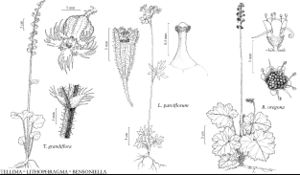Tellima
in J. Franklin et al., Narr. Journey Polar Sea, 765. 1823 ,.
Herbs, not rhizomatous, not stoloniferous; caudex erect, scaly. Flowering stems erect, leafy, 40–90 cm, densely stipitate-glandular. Leaves in basal rosette and cauline; cauline leaves 2–3, alternate, relatively large, reduced distally; stipules present; petiole stipitate-glandular; blade orbiculate or ovate, shallowly 5–9-lobed, base cordate, ultimate margins serrate to crenate, apex acute or rounded, surfaces sparsely stipitate-glandular on veins abaxially, sparsely to moderately densely long stipitate-glandular or glandular-hispid adaxially; venation palmate. Inflorescences racemes, terminal from axillary buds in rosette, 14–30-flowered, bracteate. Flowers: hypanthium adnate to ovary in proximal 1/2, free 2–3 mm, green; sepals 5, greenish; petals 5, greenish white or cream to pinkish red (sometimes drying dark red); nectary tissue not seen or inconspicuous; stamens 10; filaments filiform; ovary 1/4 inferior, 1-locular; placentation parietal; styles 2; stigmas 2, (enlarged). Capsules 2-beaked. Seeds dark brown, ellipsoid, warty. x = 7.
Distribution
w North America.
Discussion
Species 1: w North America.
Based on ITS-1 and ITS-2 analysis by D. E. Soltis and R. K. Kuzoff (1995), Tellima is closest to Lithophragma.
Species 1
Selected References
None.
